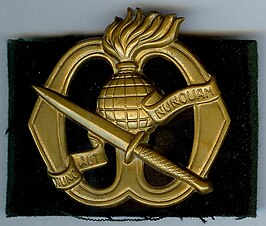Math 06 Organization | Squad
 •
by
•
by Starac202

A Division Alpha Tester
Dear citizens of the eNetherlands,
Next experimental article which will be updated in real time as usual.
😉
***
Military organization
Military organization or military organisation is the structuring of the armed forces of a state so as to offer military capability required by the national defense policy. In some countries paramilitary forces are included in a nation's armed forces, though not considered military. Armed forces that are not a part of military or paramilitary organizations, such as insurgent forces, often mimic military organizations, or use ad hoc structures.
Military organization is hierarchical. The use of formalized ranks in a hierarchical structure came into widespread use with the Roman Army. In modern times, executive control, management and administration of military organization is typically undertaken by the government through a government department within the structure of public administration, often known as a Ministry of Defense, Department of Defense, or Department of War. These in turn manage Armed Services that themselves command combat, combat support and service support formations and units.
***

Squad.
In military terminology, a squad is a sub-subunit led by a non-commissioned officer[1] that is subordinate to an infantry platoon. In countries following the British Army tradition (Australian Army, Canadian Army, and others), this organization is referred to as a section. In most armies, a squad consists of eight to fourteen soldiers,[2] and may be further subdivided into fireteams.
The equivalent to squad is the Gruppe, a sub-unit of 8 to 12 soldiers, in the German Bundeswehr, Austrian Bundesheer and Swiss Army.
Leadership
A squad is led by an NCO known as a Squad Leader.[6] His/her second in command is known as an Assistant Squad Leader. In Britain and in the Commonwealth, these appointments are known as Section Commander and Section 2IC ("second in command"), respectively.

***
Geweergroep
Een geweergroep of tirailleurgroep of gewoon groep binnen de Nederlandse krijgsmacht is een onderdeel van een peloton en bestaat doorgaans uit 10 personen. Aan het hoofd van een geweergroep staat een onderofficier, meestal een sergeant. Dit is de groepscommandant (GPC). De groepscommandant wordt geassisteerd door de plaatsvervangend groepscommandant (plv GPC), meestal een korporaal. Sinds kort worden deze korporaals die een partiële leidinggevende functie uitvoeren "leidinggevende korporaals" genoemd. Zij zijn te herkennen aan de gekruiste geweren boven hun onderscheidingstekens.
Hoewel militaire operaties meestal uitgevoerd worden op compagnie-niveau of hoger, worden special forces-operaties, operaties ver achter vijandelijke linies en het beveiligen van gebouwen nog vaak uitgevoerd op groepsniveau, omdat een grotere formatie kan leiden tot ontdekking van de eenheid of omdat een kleine eenheid nodig is om te manoeuvreren in kleine ruimten.
***

Korps Mariniers
Een geweergroep binnen het Korps Mariniers bestaat uit acht personen: een sergeant, een korporaal en zes mariniers.
Drie geweergroepen vormen samen met de pelotonsstaf een peloton van ongeveer 30 personen.

Militairen van het Korps Mariniers beveiligen direct de omgeving nadat ze door een transporthelikopter zijn gedropt.
***

Korps Commandotroepen
Een groep wordt binnen het Korps Commandotroepen specopsploeg (speciale operaties ploeg) genoemd. Aan het hoofd van deze ploeg, die uit acht personen bestaat, staat een luitenant. Elke commando binnen de ploeg (inclusief de ploegcommandant) heeft één van de vier individuele specialisaties:
communicatiespecialist (COMSPEC'er)
sluipschutter (SNIPER)
demolitiespecialist (DEMSPEC'er)
medisch specialist (MEDIC)
3 of 4 Specopsploegen zijn samen een peloton. Die staan direct onder bevel van een commandotroepencompagnie (cotrcie). Ook een enkele ploeg kan direct onderbevel van de cotrcie fungeren voor de duur van een missie, operatie of oefening.
***
x
x
x
***
***

Legendary Special Operations Forces (SOF) Instructors
Professors Milan Vukelić and Dusan Jakovljević
at Vidovdan Sabor of Serbian Knights 2015 (video)
*****
Serbian Armed Forces www.vs.rs
General Staff Units | the Guard | Special-purpose Compounds |
MP Special Purpose Battalion Cobras
Professor of physical education Milan Vukelic,
Captain 1st Class in retirement, born in 1948.
Black belt 3rd Day for judo, 5th Day for jiu-jitsu, higher sport trainer for judo and instructor in alpinist climbing, started practising judo in 1965 at the Non-commissioned officer’s school in Sarajevo.
my only true (Facebook) friend,
The First Serbian Vidovdan Knight:
I HAVE TO, I CAN, I WILL | IK MOET, IK KAN, IK WIL | ЈА МОРАМ, ЈА МОГУ, ЈА ХОЋУ
***
TEST
***
x
***
Military ranks of Serbia
***
Military ranks of the Dutch armed forces
***
Organization
An organization or organisation is an entity comprising multiple people, such as an institution or an association, that has a collective goal and is linked to an external environment

Royal Netherlands Army
***
x
***
Nonprofit organization
A nonprofit organization (NPO, also known as a non-business entity[1]) is an organization whose purposes are other than making a profit.[2] A nonprofit organization is often dedicated to furthering a particular social cause or advocating for a particular point of view. In economic terms, a nonprofit organization uses its surplus revenues to further achieve its purpose or mission, rather than distributing its surplus income to the organization's shareholders (or equivalents) as profit or dividends. This is known as the distribution constraint.[3] The decision to adopt a nonprofit legal structure is one that will often have taxation implications, particularly where the nonprofit seeks income tax exemption, charitable status and so on.
***
To be continued
*****
THE PROFESSIONALS:
Special Operation Forces (SOF) Global Security
*****
11 Airmobile Brigade - Royal Netherlands Army
16 Air Assault Brigade - British Army
Special Brigade - Serbian Army
- 63rd Parachute Battalion
- 72nd Reconnaissance-Commando Battalion
- MP Antiterrorist Battalion Falcons
MP Special Purpose Battalion Cobras - Serbian Armed Forces
Royal Netherlands Marechaussee
Commando Corps - Royal Netherlands Army
Marine Corps - Royal Netherlands Navy
****
**** Netherlands Chief of Defence - Commandant der Strijdkrachten
**** Serbian Chief of General Staff - Начелник Генералштаба Војске Србије

Picture
😛Serbian Armed Forces | General Staff Units | the Guard
DAF AND SAF | A Division Alpha Tester
- International Security
- Force Interoperability

Partnership for Peace (PfP)
Partnership tools
Yours,
Zoran Stevan Petrovic
Old Man | Starac202 | Alpha Tester
Military attaché | Militair attaché | Vojni izaslanik
😉

Special Forces in Business
Commando Business Club
***
Supplement
🙂
Basics of computer architecture
At the heart of any computer, modern or early, is a circuit called an ALU, or Arithmetic Logic Unit. It's comprised of a few simple operations which can be done very quickly. This, along with a small amount of memory running at processor speed called registers, make up what is known as the CPU, or Central Processing Unit.

A typical schematic symbol for an ALU: A & B are operands; R is the output; F is the input from the Control Unit; D is an output status
A CPU isn't very useful unless there is some way to communicate to it, and receive information back from it. This is usually known as a Bus. The Bus is the input/output, or I/O gateway for the CPU. The primary area with which the CPU communicates with its system memory in what is commonly known as RAM, or Random Access Memory. Depending on the platform, the CPU may communicate with other parts of the system, or it may communicate just through memory.

The "word" size of a platform is the native amount of bits that can be moved over the bus that is internal to the CPU.* Early computers varied on bit sizes, but most modern computers work in multiples of 8 bits, commonly known as a Byte. The first general purpose CPU on a chip, built by Intel, was the 8080 built in 1974. The 8080 used an 8 bit word, meaning it would communicate over the bus 1 byte at a time. In contrast, the 80386 has a 32 bit (4 byte) word, and the IA64 is a 64 bit (8 byte) word.
Note that a few companies considered the "word" size to be number of bits transferred at one time over the CPURAM bus. Technically, knowing the actual "word" size inside the CPU can be quite important for people developing system level software, such as device drivers.
https://en.wikiversity.org/wiki/School:Computer_Science
https://en.wikiversity.org/wiki/School:Information_technology


Comments
Interesting!
Ik denk dat ik licht hypo-manisch ben. Productiviteit verhoogd!